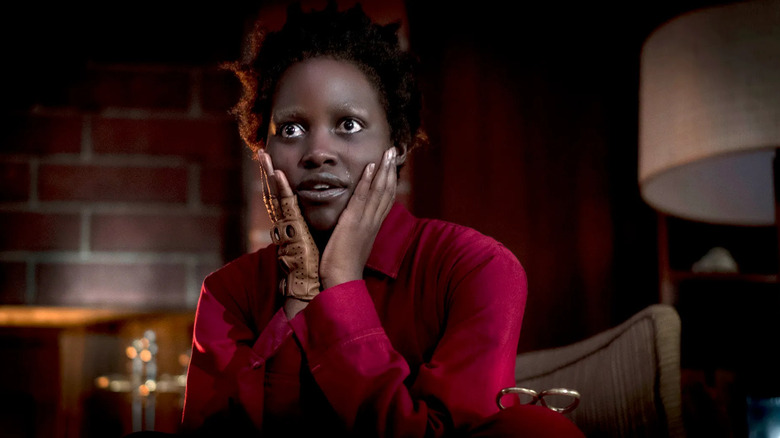
With his long-awaited third feature, "Nope," hitting theaters in a few short months, it feels like the perfect time to delve into Jordan Peele's directorial influences. Although little has been revealed about the forthcoming film's plot, it is easily one of the most anticipated titles of the summer — and honestly, the hushed mystery surrounding it only adds to the hype.
Bursting onto the scene with his directorial debut, "Get Out," in 2017, Peele effectively reinvigorated the socially conscious horror film by focusing on the grim reality of racism in America. He proved his horror prowess wasn't just a fluke with his 2019 follow-up, "Us," which features a stirring dual lead performance from Lupita Nyong'o as a woman named Adelaide and her evil "tethered" doppelgänger. To prepare Nyong'o for the demanding role, Peele gave her some "homework": nine horror films, each brimming with parallels to "Us" and the director's broader cinematic inspirations. As such, it would be easy to classify the list as a blueprint of the filmmaker's favorites.
Let's unpack this list, examining their common themes and what they reveal about Peele's creative process.
Modern Horror Staples
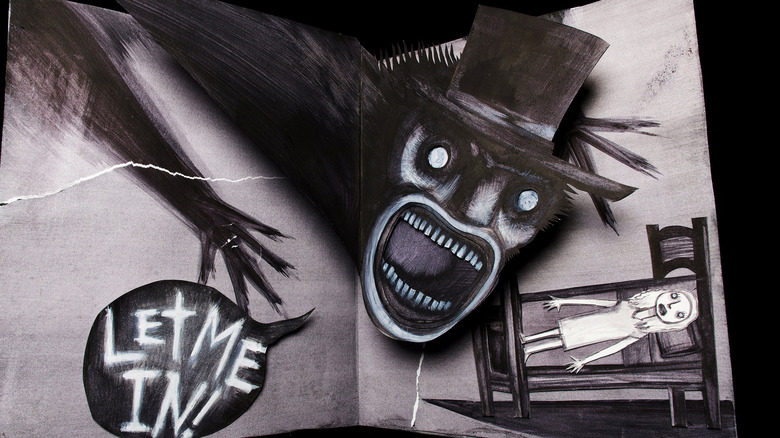
Often classified as an "elevated" horror film (though the term is largely debated), "Get Out" came on the heels of horror films that revamped critical interest in the genre. Often focusing on social themes as opposed to "senseless" violence and gore, it's easy to see how films such as Jennifer Kent's "The Babadook" and David Robert Mitchell's "It Follows" made it to Peele's list. Both premiered at the 2014 Sundance Film Festival, generating a ton of early buzz. Writing about "It Follows," /Film critic Germain Lussier dubbed it "one of the scariest horror films in years." Another /Film review noted "The Babadook" was also "one of the best horror movies in years." It was hard to classify the titles as anything other than bar-raising and genre-shattering. Both still endure as bone-chilling in their wildly varied scopes, and their direct effect on Peele is tangible.
In "The Babadook," a family is devastated after the death of a husband and father. Stepping in to fill the void is the titular monster, who straddles the line of ghostly visage and psychological tormentor. Revealing unsettling truths about motherhood, grief, and child-rearing, it certainly feels like a lot of the dramatic cues are melded into the story of "Get Out," albeit with a dramatically different purpose. Instead of the grief of losing a loved one manifesting into a mad-hatted entity, the spirits of dead ancestors are grafted into Black bodies, adding a horrifying, racial overtone while inverting the process of possession that "turns" Kent's matriarch into a murderess.
"It Follows," on the other hand, uses unassuming human vehicles to commit acts of horrific violence against those who are targeted for death. While the STI-inspired element has been long noted, Peele certainly takes inspiration from the uncanny "humans" in "It Follows" for his "tethered" doppelgängers in "Us." They look human — perhaps some even are human — but their unquenchable bloodlust makes them into monsters. With the "tethered" family of doppelgängers trailing Adelaide (Nyong'o) and her family, the hopeless sense of being caught also permeates "Us" with the same dread in "It Follows."
Familial Torture
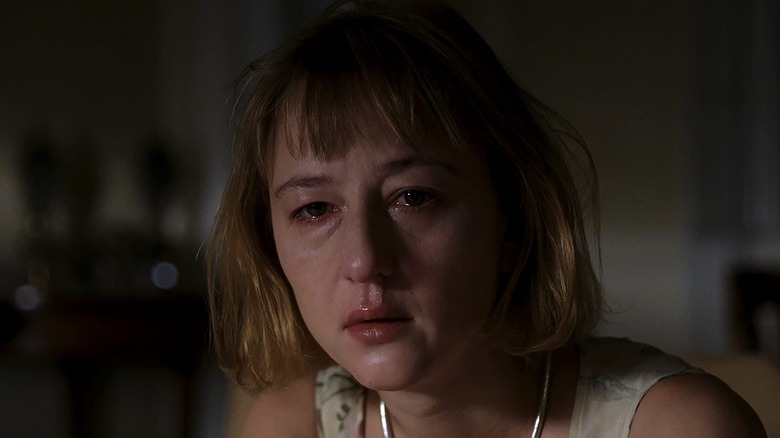
Speaking of familial dynamics, nothing suffuses "Get Out" and "Us" with more terror than the idea that an otherwise idyllic family might be harboring heinous secrets — or perhaps are the unwitting target of unspeakable torture. The next two additions to the list, Michael Haneke's 1997 brutal "Funny Games" and Pascal Laugier's relentlessly violent "Martyrs," perfectly showcase Peele's fascination with the nuclear family at war. The home invasion plot of "Funny Games" is totally palpable in "Us," particularly the scene where the "tethered" family confronts their alters in their living room. Although "Funny Games" is much bleaker (and a larger commentary on societal desensitization toward violence on screen), "Us" takes a cue from Haneke — children aren't spared, and it's brutal to witness.
"Martyrs," on the other hand, feels much more appropriate in conversation with "Get Out." While the white nuclear family in Peele's debut is certainly deranged, they stick together to fulfill a common goal. In "Martyrs," notoriously one of the most brutal of the New French Extremity cinematic movement, another unassuming family harbors a terrible secret of their own. They are pawns in the quasi-religious scheme to create "martyrs," tortured subjects who learn to love their pain. In "Get Out," the white family uses Black bodies for their own gain as well — by forcing a Black person's body to be inhabited by a white person's consciousness, it's easy to dismiss the tangible violence of racism. As such, in "Get Out," the Black victims are taught that their suffering is excusable because it advances the lifespan of wealthy white people. While there might not be an extended skin-flaying scene, the shared mentality of subjugation makes "Get Out" just as disturbing.
Doubles And Doppelgängers
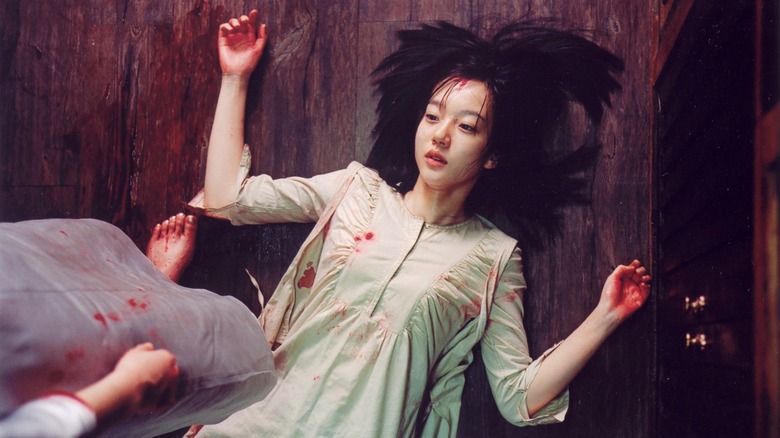
Here's where the inspiration for the doppelgängers in "Us" shines through. Next on the list are Kenneth Branagh's "Dead Again," Stanley Kubrick's "The Shining," and Kim Jee-woon's "A Tale of Two Sisters." All three employ radically different approaches to the idea of doubles and doppelgängers, and they're invaluable references.
Branagh's 1991 film "Dead Again" features a heady plot that centers on spiritual and corporeal reincarnation: A 1940s murder appears to replay in the early '90s. With Branagh and Emma Thompson playing the victims past and present, "Dead Again" toys with the idea of repeated fate. This is clearly mined in "Us," particularly with the mirrored actions (and fated defeat) of the "tethered." When it's revealed that Adelaide may not be who she seems, the intellectual query on human nature feels equally relevant in "Dead Again."
With "The Shining," it's almost self-explanatory. The Grady Twins, the pastel-donning ghosts that torment Danny in the halls of The Overlook Hotel, are at once innocent and corrupted. They appear wearing matching gowns, hands interlocked. "Come play with us," they chime in unison. When they appear again, Danny sees flashes of their maimed corpses — their father, the previous winter attendant, killed them with an ax. The twins — once pristine, now slaughtered — represent the duality of Adelaide's children and their doubles. While the "normal" children are relatively sheltered from the world's evil, the "tethered" kids are all too aware: They were used as crude guinea pigs in a government ploy for mind control.
"A Tale of Two Sisters" approaches the idea of "doubles" from a psychological angle. Centering on a young girl who fears her life is threatened by her malicious stepmother, it's revealed that much of the perceived danger is the result of horrifying psychological trauma. This parallels Adelaide's experience in "Us" — she's plagued by the house of mirrors, where she first encountered her doppelgänger, and the trauma has made her forget her identity. This block is integral to the film's final twist — it makes sense why Peele guided Nyong'o to "A Tale of Two Sisters" for reference.
Supernatural Phenomena
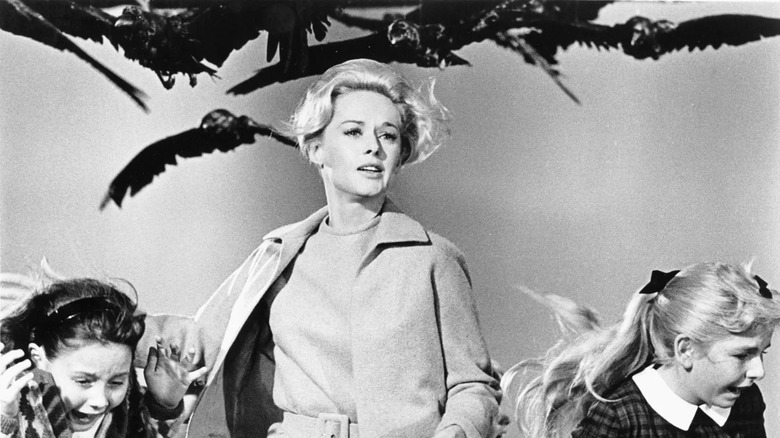
To put a cap on Jordan Peele's list, we've got two supernatural thrillers that are definite stylistic touchstones for Peele. We've got Alfred Hitchcock's classic "The Birds," starring Tippi Hedren — which is perhaps another thespian reference for Nyong'o, though her Adelaide is comparatively much cooler under pressure. But Peele has often been compared to Alfred Hitchcock, both professing a penchant for conjuring suspense and dread. "Vertigo," "Rear Window," or "Psycho" could have easily made the list, but Hedren's performance is probably what made "The Birds" the definitive Hitchcock pick for Peele.
Finally, we have the 2008 Swedish vampire film "Let the Right One In." It's important to note that Peele opted for this title as opposed to its 2010 English-language remake by Matt Reeves. Although both films are fantastic, the Swedish one imbues a concerted dual interest in what constitutes monsters versus humans — as such, its tone is a bit more comforting despite the gore it portrays. Again, this makes total sense when juxtaposing the movie with "Us." Although we at first fear the doppelgängers, the film's real villain is the U.S. carceral health care system, using disenfranchised subjects as fodder for their twisted experiments. Do we really fear the "tethered," or do we fear that our own participation in these systems might justify vengeance? The pensive through line is, ultimately, what makes a Jordan Peele film. Let's hope it's preserved and expanded upon with "Nope."
Read this next: 16 Horror Movies That Ruined Everyday Activities
The post Jordan Peele's Favorite Horror Movies List is a Perfect Study in Terror appeared first on /Film.
0 Commentaires